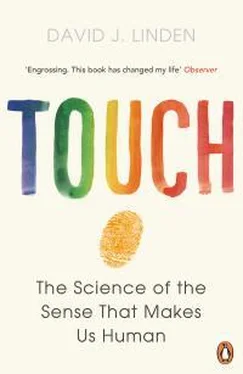All these discoveries about touch are significant, for they help us understand a central aspect of our human experience. But at this point in time our overall examination of touch has been rather limited. We need to get even messier than a kid glove full of wet oatmeal and expand our study of the tactile world. We need to explore not only blended touch sensations but also the effects of touch and nontouch senses combined. And finally, we ought to move beyond simple touch sensations to investigating phenomena like illusions, everyday hallucinations, and those transcendent touch experiences that, at first glance, seem to require a supernatural explanation.

At about the time they were three years old, my twins, Natalie and Jacob, began to play a game that would inevitably end with tears and injury. Each would stand on one side of the bathroom door, and they would take turns pushing it toward each other and laughing. The kids got along well and never engaged in conventional shoving matches, but they loved the bathroom door game. This activity was fun because each child was blocked from the other’s view, giving the door the illusion of agency, as if it had become animated with its own life force, like the objects in their favorite cartoons.
Although the game began with gentle pushes, it would inevitably escalate, each push becoming more forceful, until one child would get smacked in the head with the door and a parent would have to calm everyone down.
“Natalie, why did you push the door into Jacob’s face?”
“It’s not my fault. We were taking turns, but each time he pushed harder, so then I would push back the way he did.”
“No, Nallie!” Jacob would interject (at age three, he couldn’t quite pronounce her name). “ You’re the one who pushed harder, not me.”
“No way! It was you !”
“Kids,” I told them, “I don’t want you playing the bathroom door game. Someone always gets hurt.”
“Okay, Daddy,” they would say in unison, their promise almost instantly beginning to fade from their minds.
While there are social factors involved in this escalating-force situation, the central explanation for the phenomenon actually comes from the neurobiology of touch processing. We are wired to pay less attention to touch signals that result from our own movements as compared to those that originate in the outside world. For example, when we walk down the street, we barely notice the sensations of our clothing moving against our skin. However, if we experienced these identical sensations while we were standing still, they would be very conspicuous and would demand our immediate attention: Who or what is rubbing up against us? This makes sense: Externally generated sensations are the ones that are most likely to demand our attention because they are potentially threatening or otherwise salient (flirtatious, delicious, puzzling, etc.).
In the bathroom door game Natalie and Jacob were each trying to match the other’s pushing force in alternate turns. However, this is an almost impossible task. When Natalie pushed with two units of force, Jacob felt two units of force on his extended palms. Yet when he tried to match her with an equal amount, he exerted three units of force. Why? Because three units of self-generated force gave the same feeling of pressure on the skin of his palms as two units of force produced by his sister. Then Natalie felt three units of force from Jacob, and in her attempt to match that, she applied four units, and off they went to Armageddon. 4
The perceived attenuation of self-generated touch is seen in many different tactile situations. As discussed in chapter 6, it’s been shown that self-inflicted pain is rated as less intense and less unpleasant than the same pain administered by another person or by stimuli that are randomly triggered by a computer. And, of course, partnered sex, in which the other person is moving independently, feels fundamentally different from self-pleasuring, where your brain can predict your own stimulating movements (even if you’re using a mechanical device like a vibrator).
What’s the neural basis of attenuated sensation during self-touching? One of the clearest answers comes from the study of tickling. Most people can’t tickle themselves effectively; the tactile sensation from self-tickling is much weaker than that which results from being tickled by another person. Sarah-Jayne Blakemore and her colleagues at the Institute of Neurology in London have performed experiments in which subjects were either tickled or instructed to self-tickle while they were in a brain-scanning machine. The experiment was carefully controlled so that the location, force, and pattern of the tickling were the same in the tickling and self-tickling cases. Tickling resulted in activation of both the sensory-discriminative portions of the touch circuit, such as the primary and secondary somatosensory cortices, as well as certain regions in the emotional-affective-cognitive touch circuit, such as the anterior cingulate. When the experiment was repeated with self-tickling, activation of the brain’s touch centers was reduced when compared with conventional tickling. At the same time, self-tickling produced a strong stimulation of the cerebellum, a brain structure that receives both touch signals and instructions from other brain regions that initiate motion, like the electrical signals that flow through neurons to control muscles in the hand and arm during self-tickling. The cerebellum is activated when instructions for motion are specifically correlated with sensory feedback from the skin’s touch sensors. It then sends signals to the brain’s touch centers (and other regions) that dampen that activation and thereby attenuate the ticklish sensation during self-tickling. 5
The failure of self-tickling is dependent upon close correlation between the tickling movement and the touch sensation. When a computerized mechanical tickler 6was interposed between the self-tickling hand and the skin such that the movements of the hand were translated into movements on the skin, not immediately, as would occur with natural self-tickling, but rather with a delay of 200 milliseconds, then the self-tickling sensation became much stronger. When the direction of the tickling was altered by the computer (changing up and down to side to side, for example), it produced further increases in the efficacy of self-tickling. Brain imaging in those conditions revealed that as the commands for movement were uncoupled from the skin sensations on the tickled body part, cerebellar activity was reduced, resulting in increased activation of the brain’s touch circuit and increased ticklishness. 7Interestingly, some people with cerebellar damage can tickle themselves effectively, as can some schizophrenics (who may also have cerebellar dysfunction). It may be that in both of these conditions the cerebellar circuits, which function to compare commands for motion with sensory feedback, are malfunctioning. The result of this malfunction is that self-generated touch sensations feel as if they were coming from the outside world. 8
The tactile confusion that occurs in the cases of schizophrenia or cerebellar damage is reminiscent of another state that all of us have experienced: During dreaming sleep, we often hallucinate and are confused about the origins of sensation. In one report women who had just been awakened from the REM stage of sleep (the stage when storylike dreaming is most likely to occur) reported a greater response to self-tickling than to conventional tickling. 9Perhaps the relevant circuits for dialogue between the cortex and the cerebellum are suppressed during REM sleep and take time to come back online after waking. During REM sleep, commands flow from the brain’s motor-control centers, but they are actively blocked so that they cannot reach the spinal cord and ultimately control the muscles. Because of this blockade the body goes almost totally limp, and even the muscles that are normally contracted during other stages of sleep become relaxed. For that reason you can’t maintain REM sleep while sitting in a chair—you’ll eventually slump over and awaken. 10
Читать дальше













